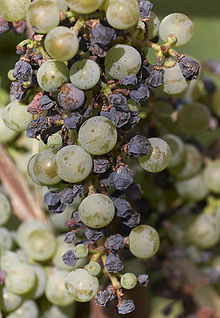Greeneria uvicola
| Guignardia bidwellii | |
|---|---|
| Scientific classification | |
| Kingdom: | Fungi |
| Division: | Ascomycota |
| Subdivision: | Pezizomycotina |
| Class: | Dothideomycetes |
| Order: | incertae sedis |
| Family: | Botryosphaeriaceae |
| Genus: | Guignardia |
| Species: | G. bidwellii |
| Binomial name | |
|
Guignardia bidwellii (Ellis) Viala & Ravaz (1892) |
|
| Synonyms | |
|
Naemospora ampelicida Engelm. [as 'Naemaspora'] (1863) |
|
| Black rot of grape | |
|---|---|

damages on fruits
|
|
| Causal agents | Guignardia bidwellii |
| Hosts | Grapevine |
| Vectors | rain |
| EPPO Code | GUIGBI |
| Distribution | originated from eastern North America, but now occurs in portions of Europe, South America and Asia |
| Symptoms | small, brown circular lesions on leaves, "mummies" on fruits |
| Treatment | choice of right cultivars, mixture of cultural and chemical control practices |
Naemospora ampelicida Engelm. [as 'Naemaspora'] (1863)
Sphaeria bidwellii Ellis (1880)
Physalospora bidwellii (Ellis) Sacc. (1882)
Laestadia bidwellii (Ellis) Viala & Ravaz (1888)
Phyllostictina uvicola (Berk. & M.A.Curtis) Höhn. (1919)
Botryosphaeria bidwellii (Ellis) Petr. (1958)
Phyllosticta ampelicida (Engelm.) Aa (1973)
Carlia bidwellii (Ellis) Prunet (1989)
Grape black rot is a fungal disease caused by an ascomycetous fungus, Guignardia bidwellii, that attacks grape vines during hot and humid weather. “Grape black rot originated in eastern North America, but now occurs in portions of Europe, South America, and Asia. It can cause complete crop loss in warm, humid climates, but is virtually unknown in regions with arid summers.” 4 The name comes from the black fringe that borders growing brown patches on the leaves. The disease also attacks other parts of the plant,“all green parts of the vine: the shoots, leaf and fruit stems, tendrils, and fruit. The most damaging effect is to the fruit”. 3
Grape black rot affects many grape growers throughout the United States, therefore, it is important to understand the disease life cycle and environmental conditions to best manage the disease. Once infection takes place, different methods are available to control the disease.
Guignardia bidwellii Disease cycle picture] The grape black rot pathogen overwinters in many parts of the grape vine and is able to over winter on the ground [especially in mummies]. In addition, pathogen can overwinter for at "least 2 years within lesions of infected shoots that are retained as canes or spurs."4 Rains release the overwintering spores (Ascospores) that form within mummies on the ground and can be blown by the wind.4 Some of the mummies on the ground can have a significant discharge of ascospores that begins about 2 to 3 weeks after bud breaks and will mature 1-2weeks after the start of bloom.4 A second type of spore (Conidia)can also form within cane lesions or mummies that have remained within the "trellis, and these are dispersed short distances (inches to feet) by splashing rain drops."4 Infection occurs when either of the spore types land on green grape tissue and tissue remains wet for a "sufficient length of time, which is dependent on temperature."4 The period that these overwintering spores are allowed to cause infection depends on the source.If there is a large source for infection, infection will set in early. In the presence of moisture, these ascospores slowly germinate, taking 36 to 48 hours, but eventually penetrates the young leaves and fruit stems (pedicels). The infections become visible after 8 to 25 days. When the weather is moist, ascospores will be produced and released throughout the entire spring and summer, providing continuous primary infection.
...
Wikipedia
